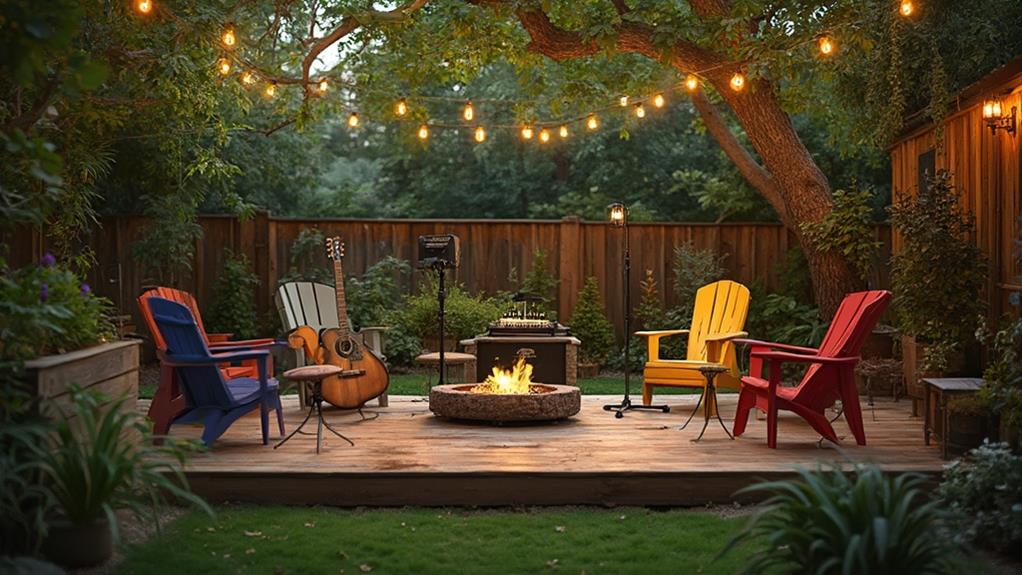Transforming your backyard into a concert space requires careful planning and execution. Start by assessing your outdoor area's size, shape, and terrain to determine optimal stage and seating locations. Design a proportionate, weather-resistant stage with proper drainage and electrical outlets. Provide flexible seating options and incorporate shade elements for audience comfort. Install a high-quality outdoor sound system with weatherproof speakers for optimal audio distribution. Implement ambient, task, and accent lighting to create atmosphere and ensure safety. Consider acoustic treatments and weather-proofing measures to enhance the overall experience. With thoughtful design and preparation, your backyard can become the perfect venue for unforgettable outdoor performances.
Assessing Your Outdoor Space
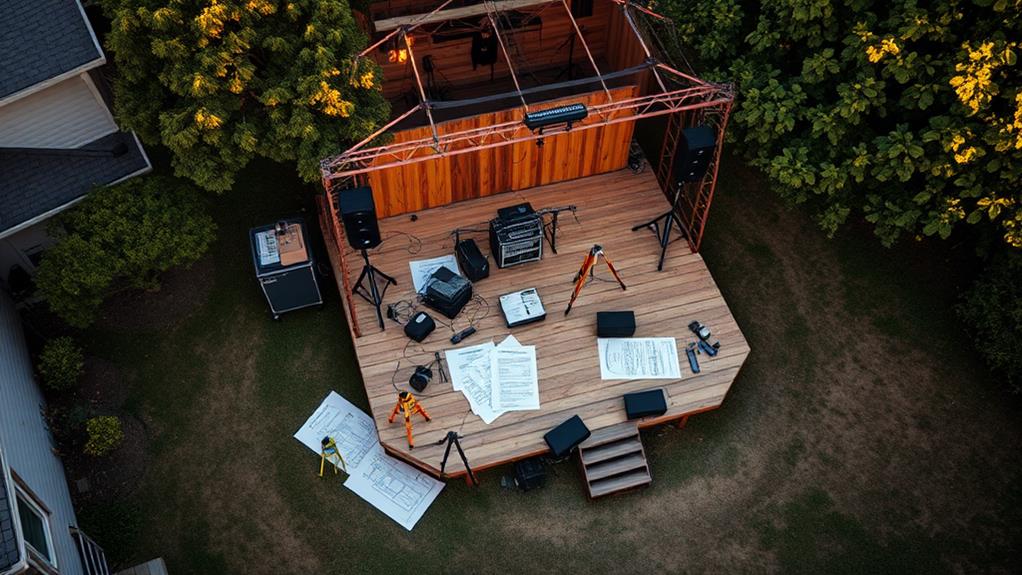
Before embarking on the creation of a backyard concert space, a thorough assessment of your outdoor area is crucial. Consider the size and shape of your yard, identifying potential locations for the stage, seating areas, and sound equipment.
Evaluate the terrain, noting any slopes or uneven surfaces that may require leveling or landscaping. Analyze the existing vegetation and structures, determining which elements can be incorporated into your design and which may need to be removed or modified.
Pay attention to natural acoustics, such as walls or fences that could reflect sound, and consider how neighboring properties might be affected by noise. Assess available utilities, including electrical outlets and water sources, as these will be essential for powering equipment and maintaining the space.
Take note of lighting conditions at different times of day, as this will influence the placement of stage and seating areas. Consider the direction of prevailing winds, which can impact sound quality and guest comfort.
Designing the Stage Area
With a clear understanding of your outdoor space, the next step is to focus on designing the stage area. The stage is the focal point of your backyard concert space, so its design and placement are crucial. Consider the size and shape of your available area, ensuring the stage is proportionate to the overall space. A raised platform, even if only slightly elevated, helps improve visibility for the audience.
Choose durable materials that can withstand outdoor conditions, such as treated wood, composite decking, or concrete. Incorporate proper drainage to prevent water accumulation. Install weatherproof electrical outlets for instruments and sound equipment. Consider adding a canopy or pergola over the stage for protection from sun and light rain.
Lighting is essential for both aesthetics and functionality. Install adjustable spotlights and ambient lighting to create the right atmosphere. Incorporate storage solutions near the stage for equipment and instruments. Finally, ensure there's easy access to the stage from both the audience area and a backstage zone. This design will create a functional and appealing centerpiece for your backyard concert space.
Seating and Audience Comfort
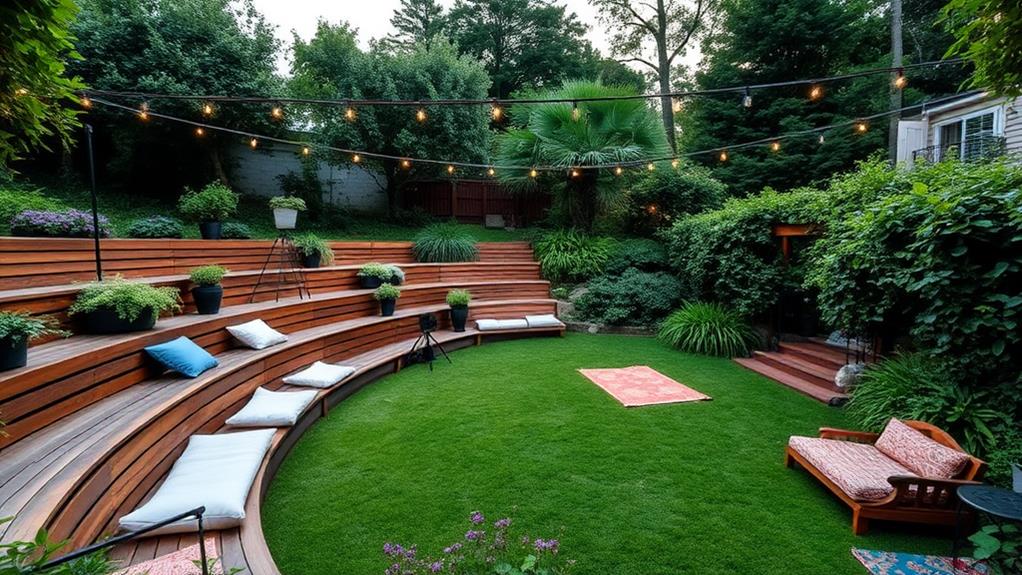
How can you ensure your audience remains comfortable throughout the performance? Start by considering seating options that suit your space and budget. Portable folding chairs offer flexibility, while built-in benches provide a more permanent solution. For a casual atmosphere, spread blankets or cushions on the ground. Tiered seating, using retaining walls or raised platforms, can improve sightlines for larger gatherings.
Weather protection is crucial for audience comfort. Install retractable awnings or shade sails to shield guests from sun and light rain. Provide adequate lighting for evening events, using a combination of ambient and task lighting to create a warm atmosphere while ensuring safety.
Temperature control is another important factor. For hot climates, consider installing misting systems or providing handheld fans. In cooler weather, outdoor heaters or fire pits can keep guests warm. Ensure proper ventilation to prevent stuffiness in enclosed areas.
Lastly, don't forget about creature comforts. Set up a refreshment area with easy access to drinks and snacks. Include trash receptacles to keep the area clean. Provide clean, accessible restroom facilities, whether permanent structures or rented portable units.
Sound System Installation
A well-designed sound system is crucial for delivering high-quality audio to your backyard concert audience. When installing outdoor speakers, consider weatherproof options that can withstand various environmental conditions. Position speakers strategically to ensure even sound distribution across the listening area, typically at ear level and angled towards the audience.
For larger spaces, implement a multi-speaker setup with delay towers to maintain consistent sound quality throughout the venue. Invest in a high-quality mixer and amplifier to control volume levels and balance different audio sources. Consider using wireless technology for flexibility in speaker placement and to minimize visible wiring.
Incorporate a subwoofer to enhance low-frequency response, especially for bass-heavy music genres. Install a dedicated power supply for the sound system to prevent overloading household circuits. Implement acoustic treatments, such as sound-absorbing panels or strategically placed plants, to minimize sound reflections and improve overall audio quality.
Consult with a professional audio technician to optimize speaker placement, system configuration, and acoustics for your specific backyard layout. Regular maintenance and periodic system upgrades will ensure consistent performance and longevity of your outdoor sound system.
Lighting for Ambiance and Safety
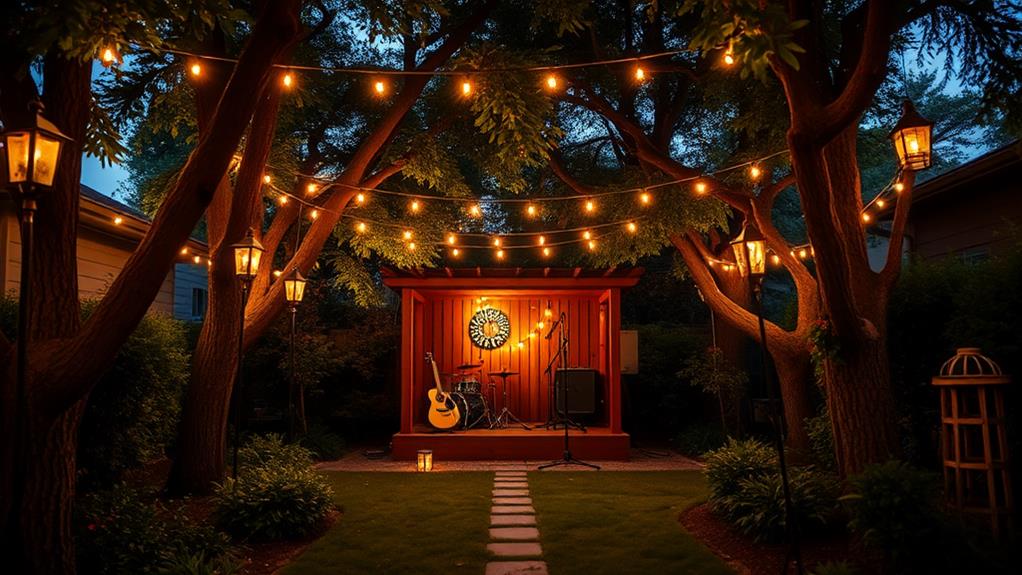
Effective lighting design plays a dual role in backyard concert spaces, enhancing both ambiance and safety. Strategic illumination creates a captivating atmosphere while ensuring guests can navigate the area securely. Layered lighting is key, combining ambient, task, and accent lighting to achieve the desired effect.
For ambient lighting, consider string lights, lanterns, or LED strips along pathways and seating areas. These provide a warm, inviting glow without overwhelming the space.
Task lighting is crucial for functional areas like food preparation stations or instrument setup zones. Use adjustable spotlights or discreet work lamps to illuminate these spaces effectively.
Accent lighting adds drama and depth to the venue. Uplighting trees, highlighting architectural features, or incorporating color-changing LED fixtures can transform the atmosphere. For safety, ensure all walkways, steps, and potential hazards are well-lit. Solar-powered path lights or low-voltage landscape lighting are excellent options for this purpose.
Incorporate dimmer switches and smart lighting systems to easily adjust the mood throughout the event. Weatherproof fixtures and proper electrical installation are essential for outdoor use. By balancing aesthetics with practicality, your backyard concert space will shine in both form and function.
Weather-Proofing Your Concert Space
When planning an outdoor concert space, weather-proofing is a critical consideration that can make or break your events. To ensure your backyard venue remains functional year-round, invest in durable, weather-resistant materials for surfaces and structures. Consider installing a retractable awning or permanent pavilion to protect performers and equipment from rain and sun. Opt for water-resistant electrical outlets and weatherproof speaker systems to prevent damage from moisture.
Proper drainage is essential to prevent water accumulation. Grade the ground slightly away from the performance area and install French drains if necessary. For flooring, use materials like composite decking or interlocking rubber tiles that resist moisture and provide traction when wet. Invest in high-quality outdoor furniture and storage solutions that can withstand various weather conditions.
To combat temperature extremes, incorporate features like outdoor heaters for cooler evenings and strategically placed fans or misters for hot days. Consider wind barriers such as hedges or decorative screens to protect against strong gusts. Finally, have a backup plan for severe weather, including a quick way to secure equipment and evacuate guests if needed. By addressing these weather-proofing aspects, you'll create a resilient outdoor concert space that can host performances in various conditions.
Acoustic Considerations for Outdoor Performances
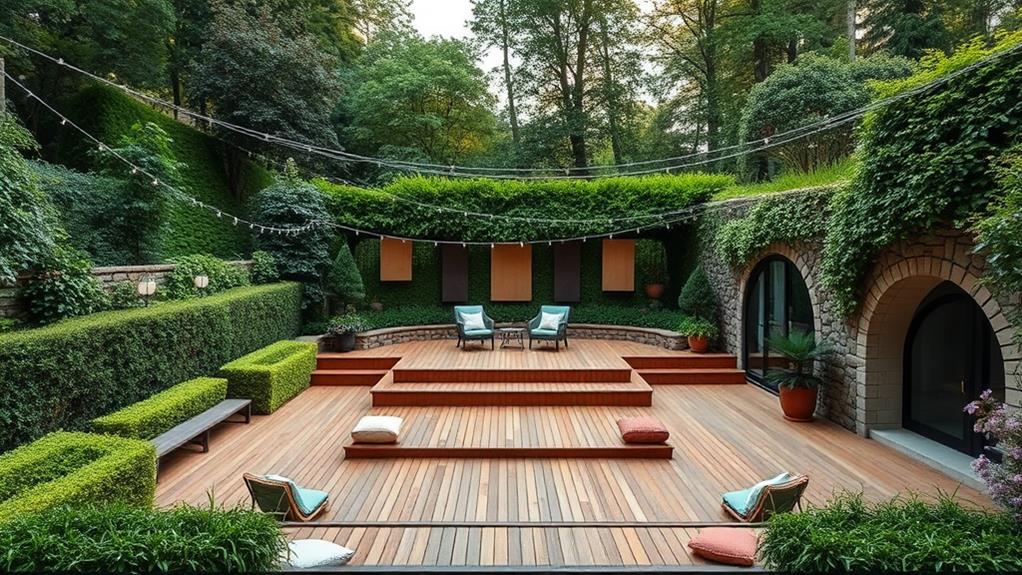
Sound management presents unique challenges in outdoor concert spaces. Unlike indoor venues, outdoor areas lack walls and ceilings to contain and reflect sound, potentially resulting in poor acoustics and reduced audio quality. To mitigate these issues, consider installing strategically placed reflective surfaces, such as wooden panels or angled walls, to redirect sound towards the audience.
Positioning speakers is crucial for optimal sound distribution. Use elevated speaker stands or mount them on poles to project sound above the crowd. Implement a distributed speaker system to ensure even coverage across the listening area. To minimize sound bleed and respect neighbors, utilize directional speakers and aim them away from residential areas.
Wind can significantly affect sound quality outdoors. Install windscreens on microphones and consider using acoustic barriers or vegetation to reduce wind interference. Ground absorption can also impact sound projection, so opt for hard surfaces like concrete or wooden decking in the performance area.
For enhanced sound control, invest in a high-quality mixing console and employ a professional sound engineer to manage levels and equalization. Lastly, conduct sound checks at different times of day to account for varying environmental conditions and adjust accordingly.
Permits and Neighborhood Regulations
Compliance with local regulations is crucial when planning a backyard concert space. Before embarking on any construction or hosting events, homeowners must research and obtain the necessary permits from their local municipality. These may include zoning permits, building permits for permanent structures, and special event permits for performances.
Many areas have noise ordinances that restrict sound levels and establish quiet hours. Familiarize yourself with these regulations to avoid potential fines or complaints. Some neighborhoods may require notification or approval from homeowners' associations before making significant changes to your property or hosting public events.
Consider engaging with neighbors early in the planning process to address concerns and maintain positive relationships. Implement strategies to minimize noise impact, such as strategic placement of speakers and use of sound barriers. Be prepared to limit event frequency, duration, and attendance to comply with local guidelines.
Consult with a local attorney specializing in property law to ensure full compliance and protect yourself from liability. By adhering to regulations and respecting your community, you can create a successful backyard concert space that enhances your property without causing conflicts.
Frequently Asked Questions
How Much Does It Typically Cost to Create a Backyard Concert Space?
The cost of creating a backyard concert space typically ranges from $5,000 to $50,000, depending on factors such as size, materials, equipment, and amenities. Basic setups may cost less, while elaborate designs can exceed this range significantly.
Can I Use My Backyard Concert Space for Other Outdoor Activities?
By Jove! Absolutely, your backyard concert space can be a versatile venue for various outdoor activities. Its open layout and potential amenities make it suitable for gatherings, outdoor movie nights, yoga sessions, or even intimate wedding ceremonies.
What's the Best Time of Year to Host Outdoor Concerts?
The best time for outdoor concerts typically falls during late spring, summer, and early fall when weather conditions are favorable. Consider factors like temperature, precipitation, and daylight hours when planning. Always have a backup plan for inclement weather.
How Do I Attract Performers to Play in My Backyard Concert Space?
90% of musicians prefer intimate venues. To attract performers, offer competitive compensation, promote your unique space on social media, network with local artists, and provide quality sound equipment. Consider partnering with music schools or local talent agencies for bookings.
Are There Insurance Considerations for Hosting Backyard Concerts?
Insurance considerations are crucial for hosting backyard concerts. Homeowners should consult their insurance provider to ensure adequate liability coverage for injuries, property damage, and noise complaints. Additional event insurance may be necessary for larger gatherings or frequent performances.
Conclusion
In transforming outdoor spaces into melodious havens, homeowners embark on a journey akin to Orpheus taming nature with his lyre. Through thoughtful design, acoustic finesse, and technical prowess, backyard concert venues can emerge as modern-day amphitheaters. Like the mythical gardens of Babylon, these spaces blend artistry with functionality, inviting both performers and audiences to bask in the harmony of music and nature. With proper planning and respect for regulations, residential lots can become sanctuaries of sound, echoing the timeless allure of open-air performances.
